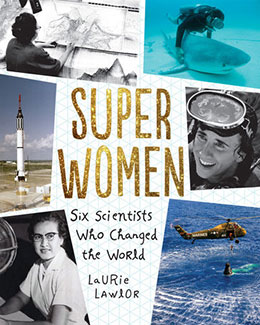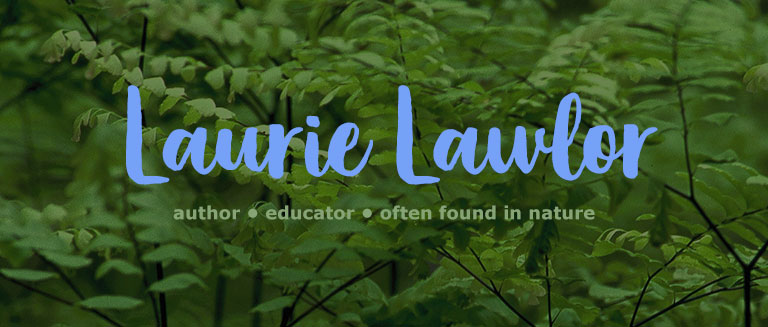Six Scientists Who Changed the World
Book Description
Profiles of six amazing women who defied prejudice to succeed in the sciences using genius, ambition, and perseverance! Laurie Lawlor deftly paints portraits of each of these pioneers who refused to take no for an answer, pursuing their passions through fieldwork, observations, laboratories and research vessels in the face of sexism. Lawlor tells the stories of:
- Eugenie Clark, an ichthyologist who swam with sharks;
- Marie Tharp, a cartographer who mapped the ocean floor;
- Katherine Coleman Johnson, a mathematician who calculated trajectories for NASA flights (featured in the film Hidden Figures);
- Florence Hawley Ellis, an anthropologist of Pueblo cultures who pioneered tree-ring dating;
- Gertrude Elion, a pharmacologist who developed treatments for leukemia and AIDS; and
- Margaret Burbidge, an astrophysicist who formulated a theory of quasars.
Awards and Recognition
- National Council for the Social Studies and Children’s Book Council Exceptional Books 2018
Resources
Super Women Discussion and Activity Guide
Super Women Match Data Answers
Super Women Word Search Answers
“Book Q&As with Deborah Kalb,” Deborah Kalb Books, 13 Aug 2017
“Super Women-Six Scientists Who Changed the World,” Sue Heavenrich, Archimedes Notebook, 6 Oct 2017
“Well-Behaved and Not So Much: Stories of Girls and Women Who Changed History,” Olugbemisola Rhuday-Perkovich, Brightly, 2017 (updated 2021)
K‑12 Resources from the Lamont-Doherty Earth Observatory, Earth Institute, Columbia University
Reviews and Comments
“Lawlor paints powerful portrayals of those who overcame barriers and refused to be labeled as quitters, forcing them to find creative ways to succeed in their careers.” (Booklist, starred review)
“Author Laurie Lawlor details the route that each woman took to make their incredible contribution to science—in drug research, zoology, research mathematics, astronomy, archaeology, and cartography. Quotes from the women, archival photos, and other background information bring their careers and personalities to life for readers. Back matter includes a glossary, source notes, index, and photo credits. A welcome addition to biographies of famous scientists.” (Suzanne Costner, Fairview Review, full review)
“Inspiring profiles of six 20th-century trailblazers. Aside from “Shark Lady” Eugenie Clark and, thanks to attention inspired by recent histories and a film, NASA “computer” Katherine Coleman Johnson, Lawlor’s subjects will likely be new to young readers. All were, as the author puts it, struck by “thunderbolts of discrimination” for being women and, in the cases of Clark (whose mother was Japanese) and Johnson (who was African-American), people “of color.” Nevertheless, they persevered, made important discoveries in their varied fields, and, eventually at least, earned significant recognition. Photos and direct quotes appear but sparingly in the narratives, but readers will come away with some sense of each groundbreaker’s character and private life to go with concise but lucid explanations of her contributions. If some of the obstacles they faced seem ridiculous to contemporary readers—in order to use the Mount Wilson Observatory in the mid-1950s, for instance, “quasar hunter” Eleanor Margaret Burbidge had to pose as her husband’s assistant and could not use the dining hall or bathroom—even now no one will argue that the playing field has leveled for women in the sciences. A handful of new role models, along with light shed on just who made certain significant advances in astronomy, archaeology, biology, medicine, and plate tectonics. (bibliography) (Collective biography, ages 11–15)” (Kirkus Reviews)
“This compilation of short biographies of six pioneering women scientists is a welcome and fascinating addition to STEM resources. Several of these women are lesser known, but some readers will recognize Katherine Coleman Johnson, the central subject of the hit movie Hidden Figures. All six women overcame great prejudice and bias in scientific fields such as aerospace, marine biology, oceanography, archaeology, astronomy, and medical research. The biographies are short but thorough and illustrated with black-and-white photographs of the scientists and their work. … Put this in students’ hands to inspire and encourage scientific pursuits. VERDICT This book hits the right notes—women, biography, and STEM—and does it excellently.” (School Library Journal)

written by Laurie Lawlor
Holiday House, 2017

